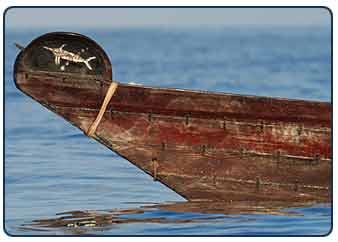Blake de Pastino
Source - http://westerndigs.org/ancient-california-islanders-used-ocean-tarballs-as-source-of-petroleum-study-finds/
Eight thousand years ago, as today, one thing you needed to get by in southern California was petroleum.
But even then, it seems, you didn’t need the top-grade stuff shipped from far away to get the job done.

Asphaltum, or raw petroleum, was an important material in the construction of plank canoes, like this modern tomol built by the Chumash community in 1996-97. (CINMS)
Unlike the refined oil that’s the coin of the realm today, prehistoric native groups used a different form of petroleum that’s one of the region’s more distictive natural resources: asphaltum.
Also known as naphtha or bitumen, and often mistakenly described as tar, asphaltum oozes from natural seeps throughout southern California and washes up on its beaches in blobs.
And archaeological evidence has shown that native peoples have made full use of it for thousands of years: as a kind of glue for fishing kits, as a waterproof coating for woven containers, and, more recently, as the key adhesive in making plank canoes.
The local Chumash were among the most prevalent users of pismu, or raw petroleum, and their languages still identify two distinct types of it: the soft, sea-borne bitumen that washes up on beaches, called malak, and the harder, higher-grade asphaltum found only in terrestrial seeps, known as woqo.
Although the land-based woqo is thought to have been more prized and widely used, it turns out that the ancient inhabitants of the Channel Islands — just a few dozen kilometers offshore — got by mainly, perhaps exclusively, using whatever malak that washed ashore.
Archaeologist Kaitlin Brown of the University of California, Santa Barbara, led a study of the bitumen found on Channel Island artifacts dating back as much as 7,700 years, and found that the petroleum originated from an underwater seep more than 40 kilometers away.

Bitumen that comes from underwater seeps can sometimes form “tar whips,” like this one found near Point Conception. (USGS)
“There has been much debate about the use of asphaltum from submarine sources in California,” Brown said in an interview.
“Ethnographic accounts state that terrestrial asphaltum was the only ‘high-grade’ source available for canoe construction. Many archaeologists believe that even the trade of asphaltum to the Channel Islands led to an increase in social complexity.”
But if the trade of this high-quality petroleum was part of what tied the region’s native groups together, she explained, evidence that islanders used their own supplies may suggest that they enjoyed a sort of ancient economic independence.
“In our article, we find that native islanders would use asphaltum from locally available sources and did not need to rely on mainland asphaltum exchange for their everyday needs,” she said.
Brown and her colleagues report their findings in the Journal of Archaeological Science
The team sampled bitumen found at six sites on two of the Channel Islands: One, dated to about 7,700 years old, was part of a fishing kit discovered in a rockshelter on San Miguel Island.
Two more were taken from a site on San Nicolas Island, where artifacts about 4,000 years old included rocks and abalone shells that were used for applying asphaltum.
Three more came from a more recent site, about 500 years old, where bitumen was processed by the island’s last native inhabitants, the Nicoleño.
The researchers compared these six samples with asphaltum taken from seeps on the mainland and with “tar balls” collected on San Nicolas island.
By analyzing the samples’ chemistry, they were able to determine their origins, because petroleum contains a unique combination of hydrocarbon compounds — like steranes and terpanes — that serves as a geochemical “fingerprint” of its source.
So using a combination of chromatography and spectrometry, Brown and her colleagues found, first of all, that the samples all had the same basic chemical makeup as the “tar balls” found on San Nicolas Island, indicating that they were all sea-borne malak, and not from the mainland.
What’s more, they were able to use the samples’ unique signature identify their source of as a specific seep on the sea floor just off the coast from Point Conception, about 45 kilometers away.

Archaeological fragments of a bitumen-coated water-bottle basket, with tarring pebbles still stuck to the interior of the bottom. (Photo by J.M.Erlandson/EHP)
This natural underwater oil well sits directly upstream, Brown’s team notes, with the prevailing current flowing right past both islands.
While providing plenty of useful insights into the technology of prehistoric Channel Islanders, these findings also have implications for the economic and political dynamics of the region over thousands of years, the team writes.
“This new evidence allows us to broaden our understanding of Native American use of asphaltum from submarine seeps, and call into question the assumption that no ‘high-grade’ asphaltum sources are located on the Channel Islands,” the researchers write in their paper.
“If the Nicoleño and proto-Chumash of San Miguel Island were able to utilize asphaltum issuing from submarine seeps for all their needs, they could maintain some degree of autonomy from mainland groups.”
Kaitlin M. Brown, Jacques Connan, Nicholas W. Poister, René L. Vellanoweth, John Zumberge, & Michael H. Engel (2014). Sourcing archaeological asphaltum (bitumen) from the California Channel Islands to submarine seeps Journal of Archaeological Science DOI: 10.1016/j.jas.2013.12.012